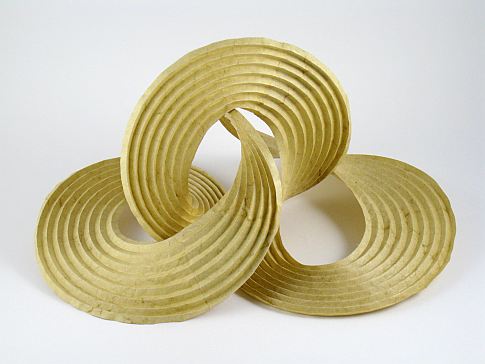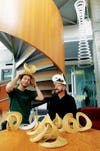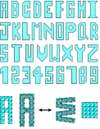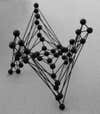Math, Art, and Origami at MIT
A father-and-son team study the science -- and art -- of folding

In the computer science lab where they work at MIT, Erik and Martin Demaine have a three-foot-tall metal and plastic sculpture that resembles a sleek, modernist version of a child’s Tinkertoy creation.
Erik, a math prodigy who was honored in Popular Science‘s second annual Brilliant 10, and his father Martin, an artist who was drawn into math through his son, built the piece by starting with a three-dimensional hexagon they folded from paper. They then inputted the shape into a computer and virtually erased all of the paper, so that only the creases remained. Next, they turned back to the tangible and created a dynamic piece of art, using aluminum rods, locked together at the joints with plastic spheres, to represent each crease.
“We took something real and virtualized it, and then made it real again,” explains Martin, 66, an MIT instructor and artist in residence.
They also took art, turned it into math and then back into art again. This belief that math and art are complementary endeavors is the key to the Demaines’ work. The men use complex mathematics to create beautiful art, some of which is on display at the Museum of Modern Art in New York City. And they construct sculptures to help solve seemingly intractable math problems. Along the way, the lively and often goofy duo have inspired students to think more creatively about their discipline, and have shown the public that math doesn’t have to feel inaccessible.
“We view them as very similar things,” says Erik, a 28-year-old assistant professor, referring to math and art. “They’re both creative processes. They’re both about having the right idea.”
The Demaines have worked in metal and glass, but are focusing mostly on paper these days, creating swirling, fluid sculptures by folding along curved creases in corkscrewed pieces of paper that are attached at the ends. They don’t yet understand why the paper responds the way it does, so they alternate between the blackboard where they scribble out equations, the computer where they work with models, and reams of stiff brown paper that they score with a laser cutter and then fold by hand.
“Mathematically, it’s not even clear what the right questions to ask are,” Erik says of the curved creases, which are at the cutting edge of folding research.
They turn to sculptures when they’re stuck on a formula, and by making incremental changes in the size and shape of the creases, patterns start to emerge. Several of their paper sculptures, including the series of three at MOMA, started as studies in the lab. They’ve begun making progress on the mathematics to prove that the shapes they’re folding can actually be made with the crease patterns they’re using.
This may seem like a strange goal — proving you can make something you just made — but the Demaines have proven just the opposite before. After 10 years of research, they proved earlier this year that a curved shape called a hyperbolic paraboloid, which they and others had been folding for years, doesn’t actually exist.
“The paper is cheating somehow,” Erik explains. Extra creases they can’t see must be sneaking into the paper while it’s folded, because the math now shows that it’s impossible to make a 3-D shape using only the creases the Demaines thought they were using.
“It’s very cool to make something that doesn’t exist,” Martin jokes.
While both men are mathematicians and artists, they have clear specialties. Erik is the math genius, having joined MIT at 20, making him the school’s youngest professor ever. His interest in folding and origami led to a MacArthur “genius” grant, dozens of papers, and a book. His research on folding goes beyond paper, such as trying to figure out why proteins fold the way they do and studying the best way to collapse robotic arms.
Martin started as a professional artist and home-schooled Erik as they traveled around their native Canada and the United States until Erik started college at 12. Martin figured Erik was a little young to leave him on his own, so he audited Erik’s classes. This helped hone Martin’s own understanding of folding, which had been a hobby of his for years.
Knowing that the men were inseparable, MIT sweetened its job offer to Erik by giving Martin a two-year position as a researcher in the computer science department. If he could prove that he was a valuable resource to the school, he could stay on. He did, and in addition to collaborating with Erik on mathematical research, he’s now the department’s first artist in residence.
The men are known as exuberant teachers, and are favorites among computer science and math students, as well as architecture, engineering and biology majors who often take their classes.
“The students are just overjoyed,” says MIT architecture associate professor John Ochsendorf. The Demaines are infinitely creative and love to have fun. Erik is known to crack corny jokes mid-lecture. (There are three kinds of mathematicians: those who can count and those who can’t.) And Martin has the curiosity of a child, constantly wondering aloud whether he can create new, interesting sculptures, such as an entire, usable bedroom set he made out of old books.
“If I could sum them up in only one word I would say ‘playful,'” Ochsendorf says.
He describes a challenge that Erik and Martin proposed: to design a brick building façade that looks like a face, but as the sun crosses the sky throughout the day the face transforms from a baby into an elderly person.
That idea, just like the Demaines’ sculptures, comes from a desire to make something beautiful that is based in hard-core mathematical exploration, Ochsendorf says. “It’s all about having fun,” he says of Erik and Martin’s work. Yet, “what comes off as playful is backed up by tremendous understanding and tremendous rigor.”

Erik and Martin Demaine

Alphabet

Folded Glass

Rods and Spheres

Hyparhedron

Computational Origami

Splash

Peel Series